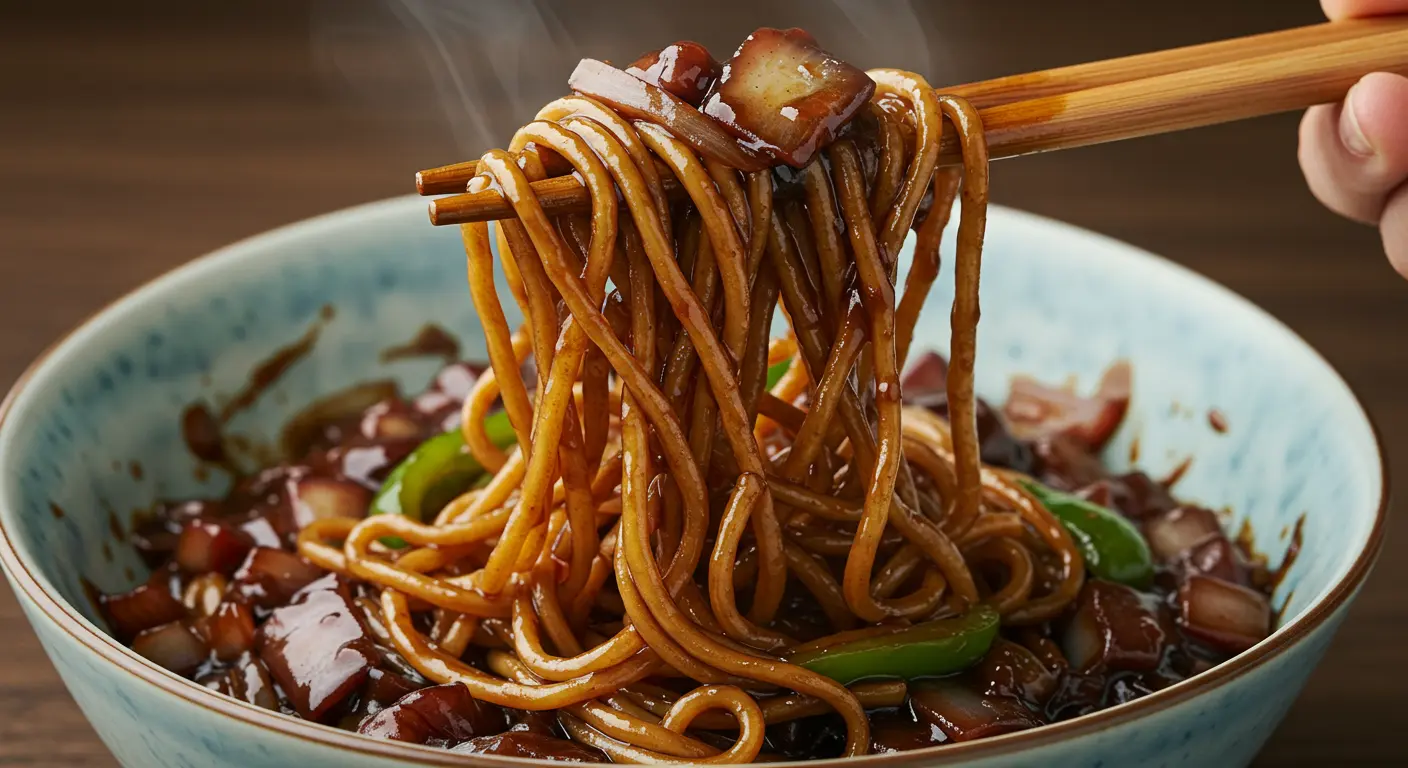There’s something deeply satisfying about a bowl of Yaki Udon , those thick, chewy noodles tangled with crisp vegetables and glossy sauce. If ramen is the cozy rainy-day classic, think of Yaki Udon as its streetwise cousin: bold, fast, and designed to be thrown together in a hot pan when hunger can’t wait.
What makes this dish special isn’t just the taste, it’s the flexibility. Some nights it’s chicken and cabbage, other nights it’s just whatever’s hiding in the back of the fridge. That’s part of its charm. In Japan, it’s the kind of noodle stir-fry you might find at an izakaya (casual pub) or as a quick home meal, proof that comfort food doesn’t need to be complicated.
In this recipe, I’ll walk you through exactly how to make Yaki Udon at home, step by step. You’ll get not only the basics, noodles, sauce, veggies, protein. But also insider tricks to keep them from sticking, to bring out that wok-fired flavor, and to adapt the dish for vegan, gluten-free, or low-sodium needs. By the end, you’ll have a reliable, flexible go-to recipe that feels just as good on a busy weeknight as it does when you’re cooking for friends.
How to Make Yaki Udon noodles

Cooking Yaki Udon is less about strict rules and more about rhythm. The whole dish comes together in about 15 minutes, but the order matters, heat, noodles, sauce, then the quick toss that pulls it all together.
Step 1: Prepare the noodles
If you’re using fresh or frozen udon, loosen them up by soaking in warm water for a minute. For dried noodles, cook them just shy of al dente, they’ll finish in the pan. Drain well to avoid excess water thinning out your sauce.
Step 2: Heat your pan
A wok is traditional, but a wide skillet works too. Get it hot, almost smoking. That initial heat gives the noodles and veggies a bit of sear, which keeps them from tasting flat.
Step 3: Cook your add-ins
Add a touch of oil, then protein (chicken, shrimp, beef, or tofu). Stir-fry until nearly cooked through, then push it to the side. Toss in your vegetables (onions, cabbage, carrots, mushrooms are classic) and stir quickly until just tender.
Step 4: Add the noodles
Slide the udon into the pan. Let them sit for 20–30 seconds before stirring, this encourages a light char instead of steaming.
Step 5: Sauce it up
Pour in your Yaki Udon sauce (soy, mirin, oyster sauce, maybe a hint of Worcestershire). Toss everything together quickly so the noodles soak it up evenly. Taste and adjust: a pinch of sugar if it’s too salty, a splash of soy if it feels flat.
Step 6: Finish & serve
Once the sauce clings to the noodles and everything’s glossy, you’re done. Garnish with scallions, sesame seeds, or even bonito flakes if you want the authentic pub-food vibe. Serve immediately.
How do I stop udon noodles from sticking?
The key is to start with well-drained noodles and a hot pan. If they clump, splash in a tablespoon of water or broth while tossing, it loosens them without watering down the flavor.
Tips & Tricks for Perfect Stir-Fried Udon noodles
Making Yaki Udon isn’t complicated, but there are a few small things that separate a just-okay stir-fry from one that feels restaurant-quality. Think of these as the little “secrets” that Japanese cooks often take for granted.
Use enough heat (but not too much)
A common mistake is starting with a lukewarm pan. If the noodles don’t sizzle when they hit the oil, they’ll steam instead of sear. That said, crank it too high and you’ll end up with burnt sauce. The sweet spot? Medium-high heat, hot enough to char veggies slightly but still controlled.
Don’t overcrowd the pan
It’s tempting to throw everything in at once, but too many ingredients drop the temperature and cause soggy noodles. If you’re cooking for a crowd, stir-fry in batches and combine at the end.
Balance salty, sweet, and savory
Yaki Udon sauce relies on umami-heavy condiments like soy sauce and oyster sauce. If yours tastes flat, add a splash of mirin or sugar. Too sweet? Counter with an extra dash of soy. Flavor in stir-fry is like a seesaw.
Let the noodles “kiss the pan”
Instead of constant stirring, give the noodles a few seconds of direct contact with the hot surface. This builds texture and that subtle smoky flavor, similar to the coveted “wok hei” you’d find in a Japanese izakaya.
Why does my Yaki Udon taste bland?
Most of the time, it’s because the sauce isn’t concentrated enough. Make sure the noodles are drained well (no extra water diluting the flavor), and let them sit briefly in the pan so the sauce caramelizes slightly before serving.
Substitutions & Variations for Yaki Udon noodles
One of the best things about Yaki Udon is how forgiving it is. It’s not a dish that punishes improvisation in fact, it thrives on it. Think of it as a template: chewy noodles + protein + vegetables + sauce. Once you’ve got that framework, the possibilities open up.
Protein swaps
Chicken or beef → Quick-cooking cuts like thigh meat or thinly sliced steak are ideal.
Seafood → Shrimp and squid both shine because they cook fast and stay juicy.
Vegetarian → Firm tofu or tempeh absorbs the sauce beautifully.
Egg → A simple fried egg on top turns this into a hearty solo meal.
Veggie variations
Classic: cabbage, onion, carrot, mushrooms.
Seasonal: asparagus in spring, zucchini in summer, pumpkin in autumn.
Quick hack: frozen stir-fry mix works surprisingly well if you’re short on time.
Sauce adjustments
Vegan → Replace oyster sauce with mushroom stir-fry sauce.
Gluten-free → Use tamari instead of soy sauce, and check noodle labels (some udon brands contain wheat).
Spicy → Add a spoonful of chili paste or drizzle with sesame oil and shichimi togarashi.
Light version → Cut soy sauce in half and add a splash of lemon juice for brightness.
Finally, Yaki Udon isn’t just another stir-fried noodle dish , everyday meals can still hit the spot. With thick chewy noodles, crisp veggies, and a savory sauce that coats every bite, it’s the kind of dinner that doesn’t need to be perfect, just a hot pan and a few minutes of your time.
The best part? It’s flexible. Some nights you can load it up with chicken or shrimp, and other nights it’s just a handful of leftover veggies and maybe a fried egg on top. No matter how you make it, it has that cozy, can’t-stop-eating flavor.
When you cook Yaki Udon at home, make it your own. Switch up the protein, tweak the sauce, toss in your favorite add-ins. And if you stumble on a version that tastes even better, pass it on.
FAQS
Even though Yaki Udon is straightforward, a few questions pop up almost every time someone makes it at home. Let’s tackle them so you’re never second-guessing mid-stir-fry.
Can I use spaghetti instead of udon noodles?
Technically, yes. Spaghetti won’t have the same chewy bite, but if you cook it al dente and toss it with a little baking soda in the boiling water (a trick borrowed from ramen hacks), it mimics the texture surprisingly well. Still, if you can get fresh or frozen udon, the difference is worth it.
How do I store and reheat leftovers?
Udon is best fresh, but you can refrigerate it in an airtight container for up to 2 days. To reheat, use a hot skillet with a splash of water or broth. Avoid the microwave if you can, it tends to make the noodles rubbery.
What proteins work best in Yaki Udon?
Thin-sliced beef, chicken thighs, or shrimp are the usual picks. Tofu is fantastic for a vegetarian version, especially if you press it first so it soaks up sauce.
Can I freeze Yaki Udon?
Not recommended. The noodles lose their bouncy texture after thawing. If you want to prep ahead, freeze just the sauce and keep noodles/proteins separate until cooking.
Is Yaki Udon the same as Yakisoba?
They’re close cousins. Yakisoba uses thinner wheat noodles and a tangier, Worcestershire-heavy sauce. Yaki Udon leans on thick, chewy udon noodles with a slightly simpler
Print
How to make Yaki Udon Noodles
- Total Time: 20 minutes
- Yield: 4 servings 1x
- Diet: Halal
Description
Yaki Udon is a delicious Japanese stir-fried noodle dish featuring thick, chewy udon noodles tossed with ground meat, fresh vegetables, and a savory-sweet sauce. This quick and easy recipe delivers authentic flavors in just minutes, making it perfect for weeknight dinners.
Ingredients
- 2 packets udon noodles (total 13 oz vacuum packed noodles)
- 2½ cups stir fry vegetables, chopped (mushrooms, bok choy, onions)
- 2 stalks scallions, cut 2 inches long
- ½ lb ground meat (beef, chicken, turkey, pork, or shrimp)
- 1 Tablespoon avocado oil
- For Yaki Udon Sauce:
- 2½ Tablespoons dark soy sauce
- 2 Tablespoons oyster sauce
- 1 Tablespoon mirin
- 2 teaspoons brown sugar
- ½ teaspoon rice wine vinegar
Instructions
- Prepare sauce: Mix all sauce ingredients in a small bowl and set aside.
- Cook udon noodles: Remove noodles from package and add to boiling water. Stir gently until separated and pliable, about 1-2 minutes. Rinse and drain under cold water.
- Stir fry: Heat pan over high heat and add oil. Add ground meat and stir fry until almost cooked. Add vegetables and continue cooking until meat is fully cooked and vegetables are soft.
- Combine: Add noodles, sauce, and scallions to the pan. Stir fry for about 3 minutes until well combined. Serve immediately.
Notes
- Use vacuum packed pre-cooked udon noodles found in refrigerated or frozen sections of Asian grocery stores
- Dark soy sauce can be substituted with regular soy sauce, though color will be lighter
- Oyster sauce provides sweet, umami flavor – substitute with hoisin or teriyaki sauce if needed
- Mirin adds restaurant-quality taste – substitute with cooking wine, sake, or stock with lemon juice
- Avoid overcooking noodles as they can become too soft
- Prep Time: 10 minutes
- Cook Time: 10 minutes
- Category: Main Dish
- Method: Stir Fry
- Cuisine: Japanese
Nutrition
- Serving Size: 1 serving (1/4 of recipe)
- Calories: 420
- Sugar: 8g
- Sodium: 1200mg
- Fat: 12g
- Saturated Fat: 3g
- Unsaturated Fat: 8g
- Trans Fat: 0g
- Carbohydrates: 52g
- Fiber: 3g
- Protein: 25g
- Cholesterol: 65mg
Keywords: yaki udon, Japanese noodles, stir fry noodles, udon recipe, Asian noodles, quick dinner, weeknight meal

